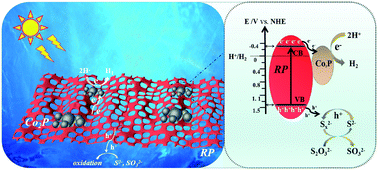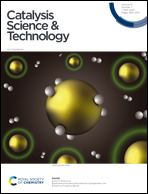In situ synthesis of Co2P-decorated red phosphorus nanosheets for efficient photocatalytic H2 evolution†
Abstract
Red phosphorus (RP) as an elemental semiconductor photocatalyst has been employed for photocatalytic hydrogen (H2) production owing to its relatively narrow band gap (about 1.72 eV), excellent absorption features in the visible region, and favourable band structure. In this work, cobalt phosphide (Co2P) as a noble-metal-free co-catalyst was first loaded on two-dimensional microporous RP nanosheets by a one-step in situ hydrothermal method. The investigations demonstrated that the introduction of Co2P nanoparticles could facilitate the separation and migration of photogenerated charge carriers and provide numerous catalytic active sites for photocatalytic H2 evolution. Besides, the stability of the composites was greatly enhanced by the formation of Co–P bonds between RP and Co2P. As expected, 2% Co2P/RP showed the highest H2 evolution rate of 5997.5 μmol h−1 g−1, which was 7.0 times and 2.4 times higher than those of pristine RP (857.6 μmol g−1 h−1) and Pt/RP (2469.9 μmol g−1 h−1), respectively. Moreover, the one-step solution-phase synthesis technology can be extensively applied for other transition-metal-phosphide-based photocatalysts.



 Please wait while we load your content...
Please wait while we load your content...